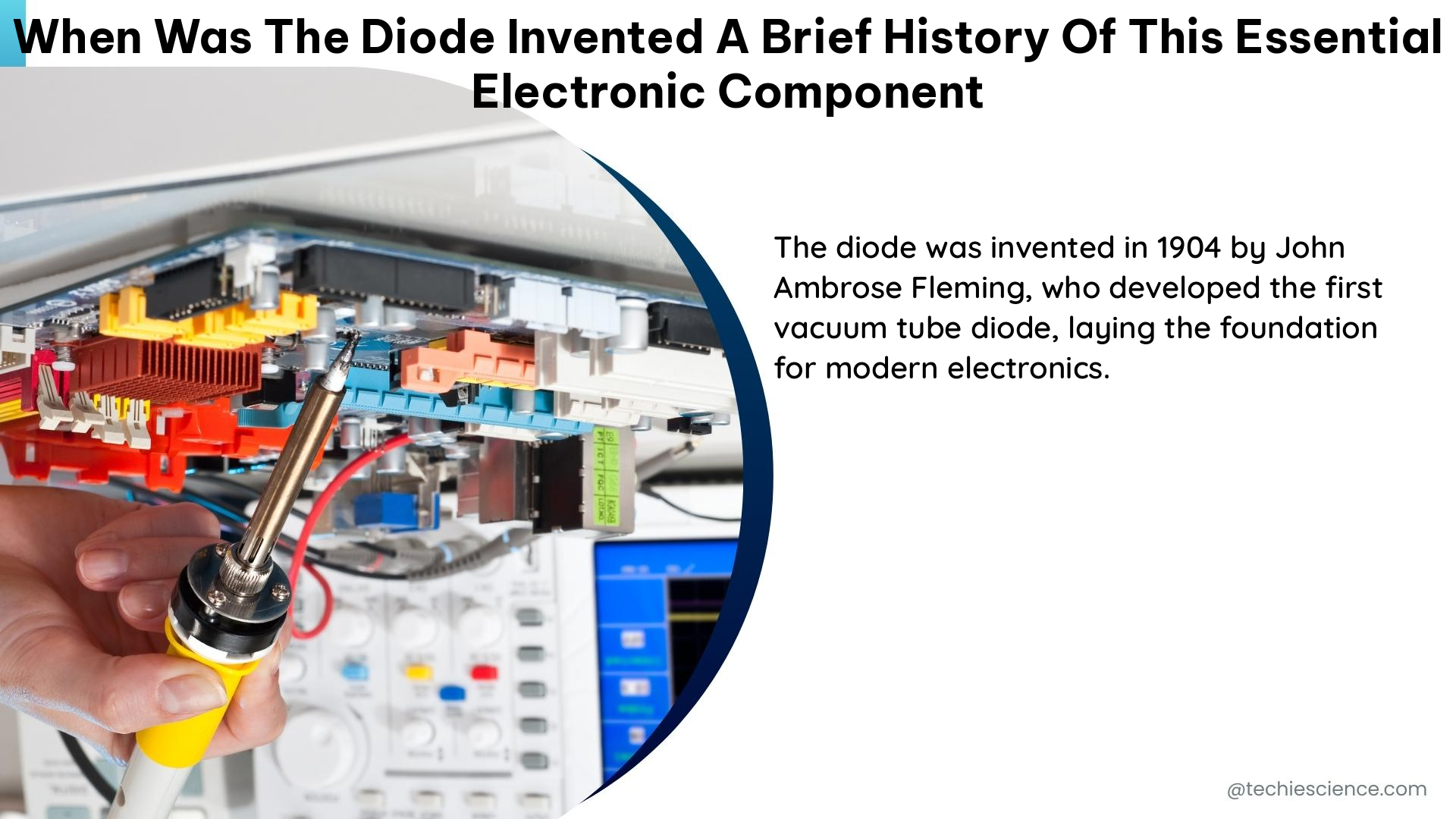The diode, a two-terminal electronic device that allows current to flow easily in one direction while presenting a high resistance to current flow in the opposite direction, has a rich history dating back to the late 19th century. The concept of diodes predates the invention of semiconductor diodes and can be traced back to thermionic diodes, which were developed around the same time as vacuum tubes in the early 1900s.
The Edison Effect and the Thermionic Diode
In 1873, Frederick Guthrie observed the unidirectional current between heated and unheated elements in a bulb, which later became known as the Edison effect. This effect was further studied by Thomas Edison in 1880, who noticed that a grounded, white-hot metal ball brought in close proximity to an electroscope would discharge a positively charged electroscope but not a negatively charged one.
Building on this discovery, in 1904, John Ambrose Fleming, an English electrical engineer, invented the first practical vacuum tube electronic device, the thermionic diode, which he patented in Britain. Thermionic diodes, also known as Fleming valves, were used extensively in early radio receivers as detectors to convert alternating current (AC) to direct current (DC).
Thermionic diodes were based on the principle of thermionic emission, where electrons are emitted from a heated cathode and attracted to a positively charged anode. This one-way flow of electrons is the fundamental characteristic of a diode, allowing current to flow in only one direction.
The Semiconductor Diode and the P-N Junction

The invention of the semiconductor diode, also known as the point-contact diode or cat’s whisker diode, can be attributed to Jagadish Chandra Bose, an Indian physicist, who in 1901 demonstrated the use of a semiconductor crystal as a detector of radio waves. However, it was not until 1919 that William Henry Eccles, an English physicist, coined the term “diode” from the Greek roots “di” (meaning ‘two’) and “ode” (meaning ‘path’).
The first documented observation of a semiconductor effect was made by Michael Faraday in 1833, who noticed that the resistance of silver sulfide decreased with temperature, which was different than the dependence observed in metals. An extensive quantitative analysis of the temperature dependence of the electrical conductivity of Ag2S and Cu2S was published in 1851 by Johann Hittorf.
The development of the p-n junction in 1939 marked a significant milestone in the history of semiconductor diodes. The p-n junction is formed when a p-type semiconductor (which has a high concentration of holes) is in close contact with an n-type semiconductor (which has a high concentration of electrons). The resulting junction has unique electrical properties that allow it to act as a diode, with a low resistance to current flow in one direction and a high resistance in the other.
Advancements and Applications of Diodes
Over the years, diodes have undergone significant advancements in terms of materials, design, and manufacturing processes. The introduction of silicon and germanium-based diodes in the 1940s and 1950s, followed by the development of high-power and high-frequency diodes, has expanded the applications of diodes in various electronic devices and systems.
Today, diodes are essential components in a wide range of electronic devices, including:
- Power supplies: Diodes are used in rectifier circuits to convert AC to DC, which is then used to power various electronic devices.
- Amplifiers: Diodes are used in amplifier circuits to provide biasing and signal conditioning.
- Switching circuits: Diodes are used in switching circuits to control the flow of current and protect sensitive components.
- Voltage regulation: Diodes are used in voltage regulator circuits to maintain a constant output voltage.
- Telecommunications: Diodes are used in modems, routers, and other communication devices to transmit and receive data.
- Lighting: Diodes are used in light-emitting diodes (LEDs) and laser diodes for various lighting applications.
The continued advancements in diode technology, such as the development of high-power, high-frequency, and specialized diodes, have enabled the creation of increasingly complex and efficient electronic systems, contributing to the rapid progress of modern electronics and communication technologies.
Conclusion
The diode has a rich history dating back to the late 19th century, with the invention of thermionic diodes in the early 1900s and semiconductor diodes in the 1910s. The development of the p-n junction in 1939 marked a significant milestone in the history of semiconductor diodes. Today, diodes are essential components in a wide range of electronic devices, including computers, power supplies, and communication systems, and continue to play a crucial role in the advancement of modern electronics.
References
- Lidia Łukasiak and Andrzej Jakubowski, “History of Semiconductors,” IEEE Transactions on Electron Devices, vol. 55, no. 1, pp. 1-16, Jan. 2008, doi: 10.1109/TED.2007.2006055.
- M. Riordan and L. Hoddeson, “The origins of the p-n junction,” IEEE Spectrum, vol. 34, no. 6, pp. 46-51, Jun. 1997, doi: 10.1109/6.604615.
- Computer History Museum, “Who Invented the Diode?,” Computer History Museum, 2013. [Online]. Available: https://computerhistory.org/blog/who-invented-the-diode/.
- Wikipedia, “Diode,” Wikipedia, 2023. [Online]. Available: https://en.wikipedia.org/wiki/Diode.
- B. Lojek, History of Semiconductor Engineering, Springer Science & Business Media, 2007.

The lambdageeks.com Core SME Team is a group of experienced subject matter experts from diverse scientific and technical fields including Physics, Chemistry, Technology,Electronics & Electrical Engineering, Automotive, Mechanical Engineering. Our team collaborates to create high-quality, well-researched articles on a wide range of science and technology topics for the lambdageeks.com website.
All Our Senior SME are having more than 7 Years of experience in the respective fields . They are either Working Industry Professionals or assocaited With different Universities. Refer Our Authors Page to get to know About our Core SMEs.